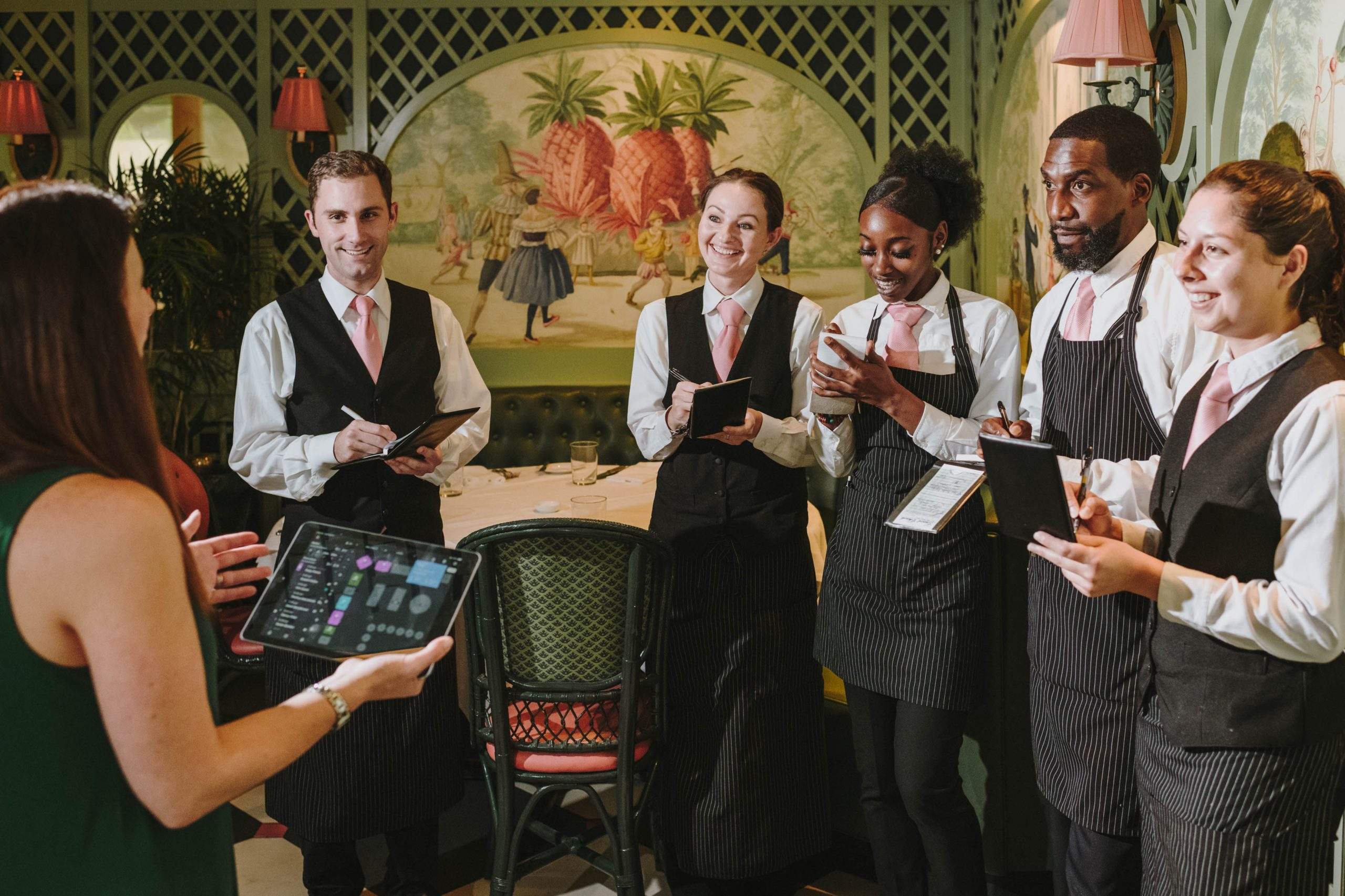The success of your marketing strategy starts with a strong restaurant marketing plan. Whether you’re running a well-established business or just about to open a new restaurant, having a well-crafted marketing plan can make a difference in your marketing efforts. A written plan serves as a guide when pitching to investors, as it helps visualize how you plan to achieve your business goals during a pitch. It is also a compass for restaurant owners to guide their marketing decisions along the way.
Here is a step-by-step guide on how to write a comprehensive marketing plan for your restaurant. Read on to learn what a marketing plan is, what it should include, and how you can quickly write one that works for you.
Quick links
What is a restaurant marketing plan?
Steps to writing a marketing plan
Defining the restaurant’s mission
Researching the market
Specifying the customer target
SWOT analysis
Setting marketing goals
Developing marketing tactics
Selecting marketing channels
Defining your marketing budget
Marketing plan resources
What is a restaurant marketing plan, and why does your restaurant need one?
A restaurant marketing plan does exactly what it says on the tin. It’s a document that outlines your marketing strategy and the marketing activities you plan to carry out in your restaurant, to reach your business goals.
A comprehensive marketing plan can help you gain insight into your competition and understand your market. Additionally, it can help you identify your target customers. Finally, it can help you decide which marketing tactics will work for your restaurant.
Steps to writing an effective marketing plan for your restaurant
Writing a restaurant marketing plan from scratch can seem daunting at first. Follow these steps to get started and you’ll see that it gets easier as you develop your vision.
1. Define your restaurant’s mission
Your restaurant’s mission is why your business exists. You can summarize it in a mission statement. It’s a clear, brief, and memorable description of your restaurant’s mission in just a few words. A mission statement is the foundation of your marketing efforts and provides a clear direction for your restaurant’s marketing strategy.
For example, if your focus is sustainability, your restaurant’s mission statement could be: “Our mission is to serve healthy and delicious food to sustainability-minded consumers in the local community, using only locally sourced and fresh ingredients.”
Here’s a template you can use to write your own restaurant mission statement:
We’re on a mission to [your restaurant’s reason why] for [your target audience] by [what / how you do it].

2. Develop your restaurant brand identity
Once you’ve written your mission statement, use this to develop a brand identity that reflects what your restaurant stands for. Your brand identity comprises all the visual aspects that make up your restaurant’s image. In this case, looks matter. It’s important that your restaurant’s image reflects your mission so your customers have the right perception of your brand. Do your restaurant’s sign, logo, interior design, menu, and website align with its mission?
3. Research your market
Your market research should include demographic information about the market: age, occupation, geographic location, and dining preferences. You can start collecting market insights simply through observation: check out other spots and observe the types of clientele they have, and how they interact with the space and people around them. Try to take notes of the tiny details, sometimes this is what makes the difference in providing a superior experience.
Beyond observing your customers, you can gather information from external websites and resources on your market. This is a fundamental step as you’d want to choose your target segment also based on reliable data.
A good starting tool is Statistics Canada, where you can explore data and insights on different consumer trends across several industries. You can also get a pulse of the restaurant industry and shifting diner preferences from OpenTable’s quarterly diner survey.
4. Specify your restaurant’s customer segment
Once you’ve researched and segmented your customers, it’s time to pick your target. Narrowing your focus on a segment of your market rather than trying to cater to every single customer might be a smart choice. Keep in mind, your restaurant has a specific mission. Your target market should also reflect your mission.

5. Complete a SWOT analysis on your restaurant
SWOT stands for Strengths, Weaknesses, Opportunities and Threats. A SWOT analysis can help you paint the picture of where your restaurant stands in the market. It allows you to reflect on your restaurant’s strengths and weaknesses.
Think of these questions when conducting a SWOT analysis on your restaurant:
- Strengths: What makes your restaurant unique? What makes diners want to book a table at your spot, and what keeps them coming back? List your business’s successful attributes and think about how you can leverage them against your competition.
- Weaknesses: What problems are currently limiting your restaurant’s growth potential? How can you overcome these challenges and what are your solutions? For example, your restaurant space is limited so you only have a few tables, and you need to think of ways you can optimize your table turnover rate.
- Opportunities: What are the external market opportunities to boost your business? Are there any industry trends that you can tap into? For example, if there aren’t many vegan restaurants in your area, can you adapt your menu to appeal to these customers? Find a gap in the market and try to offer something unique to fill it.
- Threats: What external factors or situations could impact your restaurant business? With the pandemic being a vivid memory, write down the possible shifts in the economic or political environment which could affect your business. Make sure you have a plan of action to counterbalance the risks and stay ahead of your competitors.
6. Set your restaurant marketing goals
A marketing goal outlines how you plan to achieve your restaurant’s business goals through marketing tactics. Marketing goals should be SMART (Specific, Measurable, Achievable, Relevant to your business, and Time-bound). Using this technique can help many restaurant owners establish and implement practical and achievable marketing goals.
Think about your SWOT analysis and what areas of your business require the most attention and improvement. Then focus on these aspects by implementing marketing goals.
For example, a SMART restaurant marketing goal could be to increase covers by 20% during lunch shifts or to sell 15% more appetisers to your customers. Ensure you also quantify your goals and include figures or dates to help you focus on measurable outcomes.
Then, pick one or two marketing goals at a time, and use these to guide your marketing strategy and tactics.
7. Develop your restaurant marketing tactics
Now it’s time to develop your restaurant marketing tactics, in line with your marketing goals. Think of all the marketing activities you could implement to help you work towards your goal and the channels you could leverage. Evaluate which ones are relevant to your restaurant business and require reasonable effort, both in terms of budget, staff resources, and time. Write them down so you can have a list of the activities you’re going to carry out.
Example
Marketing goal: Increase covers by 20% during lunch shifts
Marketing tactics:
- Introduce a prix-fixe lunch menu
- Promote your lunch menu on social media
- Offer discounted lunch options to employees working in nearby offices and shops

8. Select your marketing channels
A complete restaurant marketing plan must outline the appropriate channels to reach your target audiences. Use your marketing plan to outline your presence across marketing channels and consider how you plan to use these to achieve your marketing goals.
Here are the top ideas to think about:
Restaurant social media
A social media presence is key for restaurants, but this doesn’t necessarily mean you should be on all social channels. Your marketing plan outlines which social media platforms are more relevant to your restaurant, and how you plan to use these to achieve your marketing goals.
Are your customers on TikTok? Do they still use Facebook? Think of these factors to help you decide. Consider whether you want to use influencers to promote your restaurant, and make this known in your marketing plan.
Example:
On Instagram, I will regularly post pictures of the lunch options available in my restaurant to promote the lunch menu. I will also reach out to local influencers and invite them to my restaurant to create buzz around my new lunch menu.
Email marketing
An email marketing strategy can be effective both for new restaurants looking to increase their customer base or for more-established businesses to foster loyalty. In this section, think of your marketing goal and where your restaurant stands, and decide if it makes sense for you to focus your efforts on emails. Then, write down how you plan to achieve your goal with your email strategy and how the restaurant will benefit from the outcome.
Example:
I will target past visitors from my CRM database with tailored email messages to showcase my new lunch offer
Paid marketing
Paid marketing campaigns can boost your restaurant’s visibility or help you fill more seats during key moments. First, consider how and if you want to incorporate a paid campaign strategy into your marketing plan. You can then decide how much of your budget you’d like to allocate to this, depending on your business goals.
Example:
I will leverage Facebook location ads to promote my business and direct customers close-by to my restaurant location.
9. Set a restaurant marketing budget
It’s time to define how much of your budget you plan to allocate to your restaurant marketing. A well-defined budget breakdown will help keep your marketing efforts on track, optimize costs, and maximize your resources.
There’s no rule of thumb as to how much you should spend on restaurant marketing. This depends on how big or small your business is, and what goals you’re trying to achieve. Allocate a percentage of your sales to your marketing budget, and make sure to break it down further by marketing channel. This will help you decide how much you can spend on a given marketing activity.
Helpful tools to design a restaurant marketing plan
Creating an effective restaurant marketing plan is important to help your business develop. While it’s a good exercise to assess your restaurant brand and its potential, it can seem intimidating when you’re first writing your marketing plan.
Here, we’ve compiled more restaurant marketing plan ideas and free restaurant marketing templates you can use:



